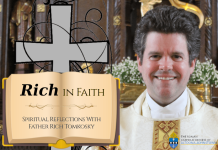A Message By Bishop Mark Bartchak
During a conversation I had with a group of teenagers, someone brought up the topic of saints.
I shared with them some of my favorites and I challenged them to do some investigation of young people who are officially canonized saints.
I asked them to think about how the lives of saints are ordinary and extraordinary at the same time.
One name that I had in mind is Saint Therese of Lisieux. I grew up knowing about her because my mother had a special affection for this saint.
Therese was my mother’s middle name. It was a popular name after Saint Therese was canonized in 1925. One of my sisters has Mom’s St. Therese statue.
Saint Therese was born in France on January 2, 1873. Her given name is Marie Francoise Therese Martin. She was one of 9 children.
As a young child, Therese was blond, blue-eyed, affectionate, precocious, and sometimes stubborn. She could throw a giant-sized tantrum, and she could make others laugh. Therese was basically spoiled by her mother.
Therese had great devotion to the Infant Jesus, and her spirituality was a childlike simplicity and trust in God’s love. This approach to Christian life has been referred to as her “little way.”
Therese was only 15 years of age when she entered the Carmelite Monastery in Lisieux to give her life to God. Actually, she was too young to join that group at the time, but she personally sought approval from the Pope to begin her life as a cloistered nun.
Therese is often referred to as “the little flower.” That’s how Therese understood herself before the Lord – simple and hidden, but blooming where God had planted her.
Therese died in 1897 at the age of 24.
So much for the life of a young, holy woman; but not exactly. There’s a lot more to the story.
I thought of the life of St. Therese because of the kind of cloistered life that we are living in this time of the COVID-19 pandemic.
Unlike St. Therese, we did not ask for the opportunity to shelter in place.
Going back to her early childhood, Therese knew about suffering. Her mother died of breast cancer when Therese was only four years old.
That’s when the precocious, and affectionate little girl, was also known for being stubborn and throwing temper tantrums.
By the time Therese started school, her father had moved the family to a different house. She did not make an easy transition to that new environment.
During her early years in grammar school, Therese was picked on and bullied by other students. Many of the children were jealous because Therese was so bright and talented.
After her mother died, her older sister Pauline looked after Therese, as a second mother. When Therese was nine years old, Pauline entered the convent and became a Carmelite nun.
This left Therese feeling abandoned again. She became physically ill and everyone thought that she was dying.
Instead of reassuring her, visitors to her bedside made her more anxious.
When Therese recovered from that illness, it was reported that she was cured by a miracle. Therese refused to explain what happened, so most of the family went around telling everyone that she made the whole thing up.
Another sadness of abandonment was felt when Therese’s other sisters, Marie and Leonie, left to join religious orders. Therese was left alone with her last sister Celine and her father.
In her own writings, Therese tells us that she wanted to be good but that she had an odd way of going about it. As her father’s spoiled, little Queen, she wouldn’t do housework.
As a young teenager, Therese tried to hide her feelings, but even the smallest negative comment would make her burst into tears.
When Therese showed interest in entering the convent, no one encouraged or supported what she believed was God’s call.
But Therese made up her mind to follow that way of life.
During the short 9 years that she was a Carmelite sister, it was not all holiness and happiness.
For a period of over a year, Therese felt as though God had abandoned her. It was a time of darkness and spiritual emptiness.
And finally, Therese contracted the dreaded disease of tuberculosis.
During her lifetime one out four people in Europe died from tuberculosis.
Tuberculosis caused widespread public concern in the late 19th century as the disease became common in cities and especially among the poor.
When tuberculosis was determined to be contagious, people who were infected were quarantined.
Many of you remember the TB hospitals that were built on the outskirts of towns and cities in the United States as a way of controlling the spread of the disease. There was one on the Summit, near Cresson.
So how is the story of a Carmelite nun who became a saint a story for our time.
Many of us have been anxious during this time of the Coronavirus. We have entered the cloister of our homes as we shelter in place.
It is a challenge not to be able to gather with family and friends as we all try to keep a safe distance.
And I am aware that for some it may be a struggle to remain connected to God.
Even with all the painful experiences of her life, St. Therese believed in God’s love for her.
In her autobiography St. Therese explains that on Christmas Eve, 1886, she had a profound awareness that love, true Christian charity, had entered her heart.
Many of you may be thinking, “How can I remain connected to the awesome love of God during this challenging time?”
This is the answer given by St. Therese in her own spiritual journal titled, Story of a Soul, She writes,
“For me, prayer is, an outburst from the heart; it is a cry of gratitude and of love in the midst of trial as in the midst of joy!”
And she adds, “Sometimes when I find myself, spiritually, in dryness so great that I cannot produce a single good thought, I recite very slowly an Our Father and a Hail Mary. These prayers alone console me; they suffice; they nourish my soul.”
In that same journal, St. Therese writes, “I understand that love comprises all vocations; that love is everything; that love embraces all people, times, and places because it is eternal!”
In our time of need today, it is so important to be reminded that love, God’s love, is everything; that it embraces all of us
This holy woman, St. Therese, knows the challenges that we face, including anxiety, aloneness, and grave physical illness.
But most important, she had a profound awareness of the presence of God in her life, even when it is interrupted or disrupted by so many things we cannot control.
In the time in which we live, we all need that same awareness of God’s presence. If you need someone to reassure you of that truth, I highly recommend that you reach out to the “Little Flower.”
I have decided to seek the intercession of St. Therese during this time of need and I invite you to do the same.
I am quite sure that Therese knows us, and what is going on in our lives these days. Our simple prayer should be: “St. Therese of Lisieux, pray for us.”






























